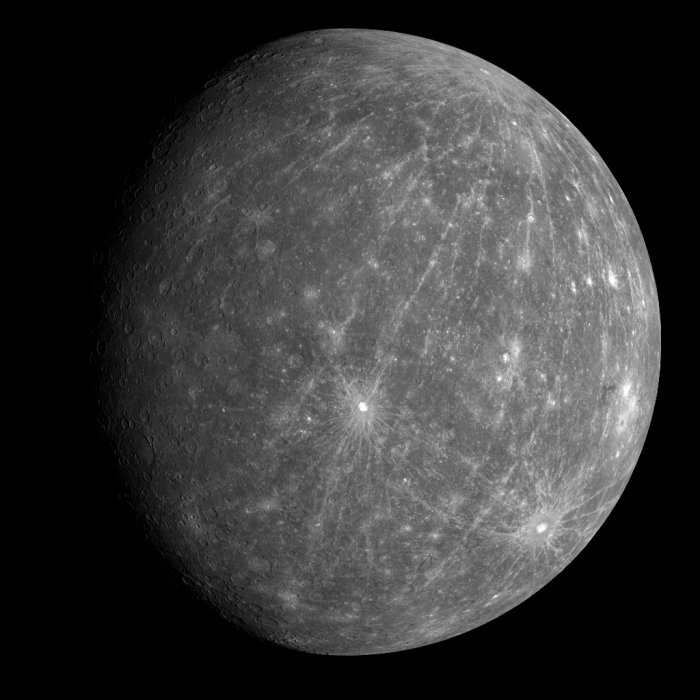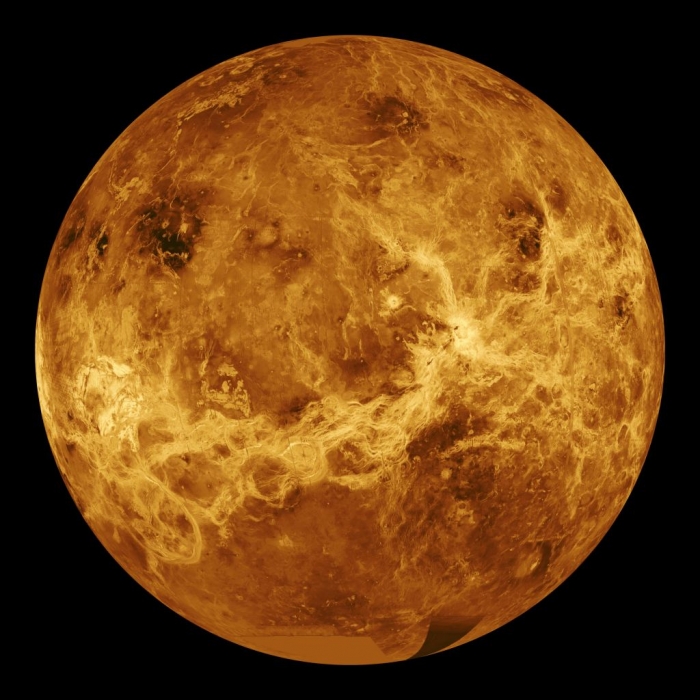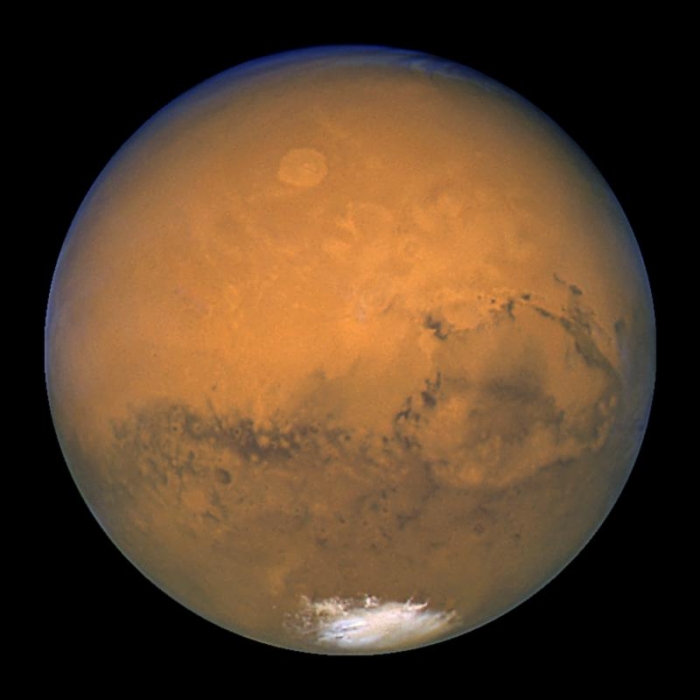Additional reading from www.astronomynotes.com
Start Here!
Please review the properties of the Inner Planets at Bill Arnett's Nine 8 Planets website, an excellent resource.
Additionally, there is a great deal of information (with no annoying ads, like in the previous link) at NASA's Solar System Exploration page.
Our goal for this lesson is to come up with a list of the similarities between the planets, some trends in their properties, and an understanding of where some of the discrepancies in their properties may lie. To achieve this, we can begin with a simple bullet list that includes a summary of the properties of each of the three Terrestrial planets:
Mercury
- Surface heavily cratered—in some ways very similar to Earth's Moon.
- Very dark—only reflects a small amount of Sunlight (it has a low albedo).
- Temperature on the surface varies from 100K to almost 700K.
- In a 3:2 synchronous orbit with the Sun—three Mercury days (59 Earth days each) = two Mercury years (88 Earth days each).
- The iron core of Mercury is very large, taking up most of the interior of the planet and creating a relatively strong magnetic field for a planet of its size.
- No moon.
- Less than the size of the Earth.
- Visited by satellite Mariner 10—most of our knowledge comes from this one mission. The NASA Messenger mission studied Mercury in recent years; it entered orbit around Mercury in March 2011 and studied it continuously before crashing to the planet's surface in 2015.
- Messenger somewhat surprisingly revealed that Mercury has water ice in shadow in craters at its poles!
Venus
- Thick atmosphere and "runaway greenhouse effect" causes 730K surface temperatures.
- Atmosphere consists mostly of CO2 (carbon dioxide), clouds of sulfuric acid—no water vapor or oxygen.
- Huge volcanoes.
- Clouds are highly reflective (high albedo)—Venus is one of the brightest objects in our night sky.
- Rotates very slowly (243 Earth days) and it rotates in a retrograde manner (opposite of the Earth & Sun).
- Not in a synchronous orbit—one Venus year = 225 Earth days.
- No moon.
- Almost identical in size to the Earth.
- A number of missions to Venus have been sent by the USA and USSR. In 1994, Magellan mapped the surface of Venus.
Mars
- Temperature always below the freezing point of water.
- Giant volcanoes (largest of any in the entire Solar System).
- Intense, large-scale dust storms.
- Has an atmosphere that is much thinner than Earth or Venus, mostly CO2.
- The surface is red because of the presence of iron oxide (rust).
- One Mars day is only slightly longer than an Earth day (24.6 hours).
- One Mars year is 1.88 Earth years.
- Polar caps of dry ice and water ice that change with the seasons.
- Frozen water in a permafrost layer (recently confirmed).
- About half the size of Earth.
- Two small, irregularly shaped moons—Phobos and Deimos.
- The most visited planet in our Solar System, including several recent missions, Mars Exploration Rovers Spirit and Opportunity, the Phoenix Lander, Curiosity, and MAVEN.
Interior structure
There are several peculiarities about these planets, but we can understand the likely causes of these properties when we contrast them to the Earth. First, consider the interior structure of these planets. Just like the Earth, Mercury, Venus, and Mars are differentiated. Curiously, we find that, compared to the other planets, Mercury's core is relatively large. That is, it fills up most of the interior of this planet. Because the core of Mercury is probably mostly made up of iron and nickel and it fills so much of the planet's interior, Mercury is the densest inner planet. We expect that some of the core of each of the inner planets is molten, and we expect that this liquid metallic core must generate electric currents inside the planet as the core rotates with the rest of the planet. These electric currents should create magnetic fields, making the planets behave as if they have giant bar magnets inside them. Both Mercury and the Earth have measurable magnetic fields, but, contrary to our expectations, Venus and Mars do not. For Venus, the reason may be that it rotates too slowly to create the necessary conditions to create a magnetic field. The lack of magnetic field on Mars may be caused by its lack of a molten core.
Albedo
We observe the inner planets easily because they are nearby and shine by reflecting sunlight. You can see Mercury, Venus, and Mars at different times of the year without any instruments like a telescope or binoculars—all three of these planets are visible to your naked eye. Although all of the planets reflect sunlight, different materials reflect different amounts of sunlight. For example, look at the Earth at the NASA: The Blue Marble site. We see that the brightest parts of the Earth are the clouds and the ice near the North Pole. The darkest parts of the globe are the patches of deep ocean that are not covered by clouds. The amount of light reflected by a surface is called the albedo. For light colored clouds, the albedo is high, and much of the incoming sunlight gets reflected. Water and dark colored rock reflect much less light. Mercury is mostly covered by dark rock, so its albedo is very low. On the other hand, Venus is covered by a thick layer of clouds, so it reflects almost all of the Sunlight that hits it. Because of Venus' high albedo and its proximity to the Earth, it is the brightest object in the night sky after the Sun and the Moon.
Atmosphere
Observations of these planets tell us that all three have atmospheres. Mercury has a very thin atmosphere with a strange composition. Mercury is so small that gas easily escapes from its gravitational pull, so its atmosphere must be regenerated continually, perhaps by the bombardment of the surface of the planet by energetic particles from the Sun. Venus, on the other hand, has a thick, dense atmosphere. The greenhouse effect has "run away" on Venus, making the surface temperature hotter than Mercury, even though it is farther from the Sun. Mars' atmosphere is much thinner than Venus or Earth, and it consists primarily of carbon dioxide. The atmosphere of every inner planet originated when the planet was formed and has been supplemented by gas that has escaped from underneath the crust.
The laws of physics tell us that the hotter a gas is, the faster the particles inside that gas move. For Mercury and Mars, these planets are so small that they have weak gravitational fields, which means that much of the gas in their atmosphere can escape if it is warm enough (the average speed of the particles in the gas exceeds the escape velocity from the planet). For Venus and the Earth, which are more massive and have stronger gravitational fields, the lightest gases can escape, but gases like carbon dioxide and nitrogen do not.
Additionally, on the Earth, we know that plant and animal life process the gas in the atmosphere. For example, humans breathe oxygen and exhale carbon dioxide, while plants use carbon dioxide and produce oxygen. Because of these biological processes on the Earth, our atmosphere has evolved significantly from its original content. The Earth's atmosphere may have once been much like Venus' atmosphere is now, however, as plant life on the Earth arose, the process of photosynthesis contributed to the removal of carbon dioxide and the increase in oxygen content.
Rates of rotation
There is also some diversity in the rotation rates of the inner planets. We are most familiar with the Earth. It rotates in a counterclockwise direction in close to 24 hours. Mars is quite similar to the Earth. Its rotation axis is tilted by 24 degrees (Earth's axial tilt is 23.5 degrees), and its rotation period is just over 24 hours. So on Mars, the length of the day and the variations in the height of the Sun above the horizon over the course of one Mars year are similar to what we are used to on the Earth. Mercury has become tidally locked to the Sun, similar to how the Moon is locked to the Earth. However, in the case of Mercury, the planet rotates in 59 days and orbits the Sun in 88 days. What this means is that Mercury rotates completely on its axis (that is, 360 degrees) 3 times in the same amount of time it takes to orbit the Sun 2 times. This is referred to as a 3:2 resonance. In the case of the Moon, since it orbits the Earth 1 time in the same amount of time as it rotates 1 time, this is referred to as a 1:1 resonance. Although this seems a bit peculiar, Venus' rotation properties are much stranger. It takes 243 days to rotate once (and there is no tidal locking, so the Venus year has nothing to do with the Venus day), but it rotates in the opposite sense compared to Mercury, Earth, and Mars. All of these planets orbit the Sun in a counterclockwise direction, and Mercury, Earth, and Mars rotate counterclockwise around their axes. Venus rotates slowly in a clockwise manner around its axis. One theory is that a collision or collisions with Venus by other objects caused its rotation sense to reverse, but an alternative theory is that the tidal influence of the Sun and the other planets in the Solar System may also have caused this unique rotation.
Want to learn more?
Recall that Starry Night allows you to travel to the surface of each planet. If you would like to compare the rotation rates, orientation of the axis of rotation, and orbital periods for each planet, you can travel to Mercury's, Venus', or Mars' surface, set the time flow rate to 3000x (or the time step rate to say 1 Earth day), and as time goes by note the location, date, and time of sunrise and sunset, the height of the Sun above the horizon, and the length of 1 day on that planet.
You can also choose to hover over a point on the surface, and if you choose to hover over the north pole of each planet, you can watch them rotate below you. For Venus, you will have to turn up the time flow rate to a very high number in order to see it rotate at all.


